| Pages:
1
..
4
5
6
7
8
..
33 |
Rosco Bodine
Banned
Posts: 6370
Registered: 29-9-2004
Member Is Offline
Mood: analytical
|
|
Quote: Originally posted by Hennig Brand  | I do understand the concept and you have worded it well. I don't know how to quantify it exactly at the moment, but DDNP seems to be somewhere half
way between lead azide and lead styphnate in terms of unequivocality. I would really like to know how the military and industrial people design their
DDNP caps.
According to TM 9-1300-214 “Military Explosives”, “an unconfined sample (of DDNP) burns with a flash if ignited but even the slightest
confinement causes a transition from burning to detonation. A charge of DDNP undergoes detonation when ignited if pressed into a blasting cap shell
with a reinforcing cap and a piece of black powder safety fuse crimped in the shell. A spark falling into the open end of such a blasting cap causes
only ignition and flashing of the DDNP.”
Those caps I made, from the above picture, were only sealed with a bit of hot melt glue at the fuse end and the cap was not reinforced. I think I can
come up with something much better. I haven’t given up on DDNP yet.
Also from “Military Explosives”, “the sand test indicates DDNP is a better initiator of detonation than mercury fulminate or lead azide for less
sensitive high explosives. The most marked evidence of this is the ability of DDNP to initiate the detonation of ammonium picrate and cast TNT. For
initiation of more sensitive high explosives, DDNP is not superior to lead azide.”
Also from “Military Explosives”, “when subjected to the sand test with ignition by a black powder fuse, the brisance of normal lead styphnate
(10.5 grams of sand crushed) is much less than that of lead azide (16.7 grams of sand crushed). “ The grade of DDNP used for military purposes,
specs taken from the same text, shall crush not less than 33 grams of sand in the sand test.
The more I read about it, DDNP sounds like it would be a great initiator for picric acid and other insensitive secondary explosives.
BTW, that Chinese primary explosive presentation, linked to in the "picramic acid from picric" thread, suggested 6mm casings be used for DDNP. It
looked like 6mm was recommended for all the primary explosive examples, but it still says something about suitable casing diameters for DDNP (I
think).
[Edited on 31-1-2014 by Hennig Brand] |
Lets take a look at TM 9-1300-214 “Military Explosives”, which you reference, now attached. I took a brief look at this text which appears to be
a pretty good presentation as military manuals go, and I have seen this one before but it has been some years ago, and I may even have the actual hard
copy manual. Anyway, just looking at the manual for 5 minutes I found an error on page 7-11 in the fourth line from the end of the page of the
government production where the quantity of lead azide given is plainly erroneous and would be immediately recognized as erroneous by any
knowledgeable person who may have been proofreading that text which is probably still taught every day as an authoritative reference textbook. The
book is WRONG right there where I say it is and that FACT can be confirmed very easily by anyone testing the matter. So you really have to be careful
about just accepting "what is written" in what may even appear to be "no bullshit" publications because it may just happen that what you are reading
and swallowing hook line and sinker is pure bullshit. There is so much of this kind of stuff found in the literature that it is impossible to believe
it is simply inadvertent error or misprint. It is on a scale that speaks of deliberate disinformation that someone in authority has decided is
propaganda needed for whatever reason. What does it make me that I am not deceived?
In an entirely different orbit from the target audience of such nonsense.
Attachment: TM-9-1300-214-Military-Explosives.pdf (1.9MB)
This file has been downloaded 1290 times
Update: These figures including the erroneous figure for lead azide looked familiar to me and this does appear to be a transcription error for tabular
values which originally appeared in a German journal article circa 1939 by Wallbaum and is cited correctly by Davis on page 441 of COPAE, but the
figure for lead azide has been quoted incorrectly off by a decimal place, which is a common error that I have seen before. The figure given in the
military manual is wrong by a multiple of 10 due to the incorrect decimal place. Sloppy editing could account for this error instead of it being
deliberate disinformation. Or the appearance of such a simple explanation to account for such an error could be an aspect of plausible deniability
about propaganda, or a deliberate test to see which student would distinguish themself for taking notice and identifying the error in the textbook.
The idea of such an error being a "test" seems
most likely. Sometimes there are errors deliberately placed in textbooks and lectures to identify which students will show aptitude by making note of
the errors and taking exception with the textbook and/or the teacher.
A case in point example is provided that if tabular values appear possible to be incorrect by a full order of magnitude, then it is entirely possible
the decimal place for the published value is wrong, but the resulting numerical value is correct when the decimal error is fixed.
Setting aside the distraction caused by making note of this error there is an item of interest on page 7-13 paragraph f
regarding the sand test for lead styphnate responding to ignition by fuse as compared with lead azide. What would be interesting as a test not
reported is to combine the two separate tests with the same quantity lead styphnate having the lead azide superimposed and the lead azide initiated by
fuse. It is predicted that the combined output would be much greater than the numerical sum for the sand crushed by the separate tests simply added
together. However the ultimate power of lead styphnate is explained
using a different example which shows that lead styphnate has more than double the output when it is initiated by lead azide, and that under high
order detonation conditions then the output power of lead styphnate exceeds the power of either lead azide or mercury fulminate mixtures. This
illustrates a very important point about the DDT property
of primary and secondary explosives which shows the sudden increase in output power that is realized for the same energetic material at the transition
from low order to high order detonation.
A followup that would seem needed is to here make note this is why a binary mixture of lead azide and lead styphnate shows a synergistic effect where
the unequivocal primary explosive lead azide functions as a homogenous booster and initiator for the lead styphnate when there is a binary mixture of
the two materials, usually with the smaller particle lead azide being the matrix with the larger lead styphnate crystals being the aggregate, the
combined composite has a greater output power than either material alone. The same principle of synergy applies to many other composite explosives
that function best as binary or multiple mixtures and can also apply for clathrates or double salts.
[Edited on 12-2-2014 by Rosco Bodine]
|
|
|
Hennig Brand
International Hazard
    
Posts: 1284
Registered: 7-6-2009
Member Is Offline
Mood: No Mood
|
|
Yes, that is an obvious error on page 7-11. I don't know for sure, but I think you would not be paranoid at all in thinking that information was
censored and also that there was a high probability that disinformation was used as well. That mistake in 7-11 is maybe not a good example of that,
just because it is such an obvious mistake, but then again I have a lot of knowledge now about the subject matter that most people wouldn't have.
Maybe, it's not a bad example after all.
Mixtures of "unequivocal" and DDT type explosives, and the synergistic effects, are very interesting. I will probably start looking into them more in
the future.
"A risk-free world is a very dull world, one from which we are apt to learn little of consequence." -Geerat Vermeij
|
|
|
Ral123
National Hazard
   
Posts: 735
Registered: 31-12-2011
Member Is Offline
Mood: No Mood
|
|
The book on azide:
Storage at 80°C for 15
months caused no decrease in brisance and, after such
storage, a priming composition containing lead azide
showed no decrease in sensitivity to stab action. The
beta form is considerably less stable than the alpha form
and undergoes decomposition much more rapidly.
I'm kinda confused now, how do you get rid of the beta form?
Here's the book on fulminate:
Storage Time required to reduce purity to 95%(near worthless according to the book)
temperature
80C - 0.5days/
50C - 8 months/
30C-1.7 years/
20C- 7 years/
10C - 8 years
From what I've heard it stores barely 6 months at slightly warmer then room temperature. What's the first question-how will the decomposition products
react the the Al/copper case and the base charge(MHN for example)
|
|
|
Rosco Bodine
Banned
Posts: 6370
Registered: 29-9-2004
Member Is Offline
Mood: analytical
|
|
The error of a decimal place has been something I believe is common based on reviews of the literature. You are correct the average reader would have
no basis to know any better and would simply trust the information. That could apply to 999 out of 1000 students who won't rock the boat. I am the
odd man out exception on that, so the error jumps right off the page at me, and I would take the red marker to it right there in class as I was
raising my hand to make the announcement about errata that got past the proofreaders, or if it is a test put there deliberately to see who is sleeping
in class then I'm answering that roll call with a shout announcing I'm not asleep or just another unit being programmed with false information that
goes right over my head. I get it.
Yeah the behavior of synergistic mixtures, double salts, clathrates, ect. is an intriguing subject as topic of study by itself. It is also a means of
achieving better economy for example with silver azide which is quite chemically stable and is an excellent initiator but will be expensive due to the
"burning up of silver" which is basically burning up money that is inherent to its use. If for example a mixture with lead styphnate 60% and silver
azide 40% it is found the initiating ability is equivalent similarly as is true for lead azide, then there is found a means of stretching ones dollar
by the "cut" of the more expensive material using the lead styphnate or possibly another even cheaper component. Such mixtures may even have superior
performance without regard to the increased economy which then comes as a bonus.
|
|
|
roXefeller
Hazard to Others
  
Posts: 463
Registered: 9-9-2013
Location: 13 Colonies
Member Is Offline
Mood: 220 221 whatever it takes
|
|
Um, does anyone see the irony of Hennig Brand copping to his decimal point error of 0.76mm. Yet we all knew what he meant. Were you just spreading
disinformation? 
|
|
|
Hennig Brand
International Hazard
    
Posts: 1284
Registered: 7-6-2009
Member Is Offline
Mood: No Mood
|
|
Ha! I thought someone might say that after the last few posts. Given my pay grade I should be entitled to a few more slips now and then, don't you
think? 
Also, I was very quick to point out the mistake. Sometimes mistakes may just be mistakes I'll give you that.
"A risk-free world is a very dull world, one from which we are apt to learn little of consequence." -Geerat Vermeij
|
|
|
roXefeller
Hazard to Others
  
Posts: 463
Registered: 9-9-2013
Location: 13 Colonies
Member Is Offline
Mood: 220 221 whatever it takes
|
|
There wasn't anything quick about it. I've been ignoring it since Feb 3rd when you first slipped up. I wasn't going to poison the well of good
conversation with a dumb response.
|
|
|
Hennig Brand
International Hazard
    
Posts: 1284
Registered: 7-6-2009
Member Is Offline
Mood: No Mood
|
|
I didn't realize I did that way back there also. Must have been thinking cm and wrote mm or something. Like you say, it was pretty obvious anyway.
What do you mean there wasn't anything quick about it? Getting a correction done to any sort of published material in nine days would be light speed I
would imagine.   
Thanks for pointing that out. It is a bit unprofessional and generally I try to avoid making those types of errors, but it happens.
[Edited on 13-2-2014 by Hennig Brand]
"A risk-free world is a very dull world, one from which we are apt to learn little of consequence." -Geerat Vermeij
|
|
|
Bert
Super Administrator
        
Posts: 2821
Registered: 12-3-2004
Member Is Offline
Mood: " I think we are all going to die. I think that love is an illusion. We are flawed, my darling".
|
|
I spent a few minutes yesterday talking with an SFX guy who was also a chemical engineer, and had been in charge of product development for a company
that made bullet hits, among other things. And he had personally made and used DDNP for bullet hits.
I am curious after our conversation. Has anyone had an accidental explosion while working with DDNP, either in production or use? Or know of any
documented industrial accidents? He seemed to think of it the way I think of organic peroxides- Bride of Satan, etc.
Rapopart’s Rules for critical commentary:
1. Attempt to re-express your target’s position so clearly, vividly and fairly that your target says: “Thanks, I wish I’d thought of putting it
that way.”
2. List any points of agreement (especially if they are not matters of general or widespread agreement).
3. Mention anything you have learned from your target.
4. Only then are you permitted to say so much as a word of rebuttal or criticism.
Anatol Rapoport was a Russian-born American mathematical psychologist (1911-2007).
|
|
|
Hennig Brand
International Hazard
    
Posts: 1284
Registered: 7-6-2009
Member Is Offline
Mood: No Mood
|
|
From the few things I have read it has, in most cases, significantly less sensitivity than the other commonly used primaries. It is very sensitive to
flame, but impact and friction sensitivity are less than most others. It is of course still a primary explosive and in relation to a secondary
explosive is extremely sensitive. It really depends on how you are making your comparisons I think. I have only worked with the material for a matter
of weeks, so obviously I am not the expert.
"A risk-free world is a very dull world, one from which we are apt to learn little of consequence." -Geerat Vermeij
|
|
|
Ral123
National Hazard
   
Posts: 735
Registered: 31-12-2011
Member Is Offline
Mood: No Mood
|
|
But you still suggest a booster made of it, mixed with TNP. I've always loved exotics.
|
|
|
roXefeller
Hazard to Others
  
Posts: 463
Registered: 9-9-2013
Location: 13 Colonies
Member Is Offline
Mood: 220 221 whatever it takes
|
|
It wasn't really a booster, so much as a compound cap with TNP as the base. The booster would be like 50g of PETN, RDX or dynamite, or whatever other
lower sensitivity material to detonate something more insenstive like ANFO or cast TNT (or maybe melamine dinitrate, yeah I'm still pondering it ). The cap is inserted into the booster and the booster inserted into the real base
charge. It's a big difference because nobody is advocating using 50g DDNP to set off anything. Just the one gram necessary for the TNP. ). The cap is inserted into the booster and the booster inserted into the real base
charge. It's a big difference because nobody is advocating using 50g DDNP to set off anything. Just the one gram necessary for the TNP.
|
|
|
Ral123
National Hazard
   
Posts: 735
Registered: 31-12-2011
Member Is Offline
Mood: No Mood
|
|
Who would waste such fine exotic materials for dynamites and anfo?
|
|
|
Hennig Brand
International Hazard
    
Posts: 1284
Registered: 7-6-2009
Member Is Offline
Mood: No Mood
|
|
Many things were considered during some of the brainstorming sessions. I wouldn't say that it was an awful idea, but there are probably better ones.
Dynamites in general are more easily initiated than TNP. For instance, 0.5g of MF or TATP will easily set of nitrate dynamites with only 15-20%
nitroglycerine. The older literature states that Picric acid can be reliably detonated with 1g of mercury fulminate, though I have never tried it. In
my tests 1g of TATP failed to detonate very pure picric acid (>98% pure). The difference in sensitive is even greater than it looks, because MF and
TATP are DDT type primaries which means that a significant amount of the primary charges would be burned up before they got up to the high velocity
needed to be effective initiators.
"A risk-free world is a very dull world, one from which we are apt to learn little of consequence." -Geerat Vermeij
|
|
|
Ral123
National Hazard
   
Posts: 735
Registered: 31-12-2011
Member Is Offline
Mood: No Mood
|
|
According to a book, cap No1 can set off efficiently 75% ghur dynamite, but for pure NG you need cap No8 or cap No1 and thick glass confinement.
For me it is a mystery why maximum density 30% NG, 70% crap can go off readily but pure maximum density mixtures(cast ETN, NG/PETN, blast jelly and
other) sometimes fail.
|
|
|
Hennig Brand
International Hazard
    
Posts: 1284
Registered: 7-6-2009
Member Is Offline
Mood: No Mood
|
|
Success Initiating Picric Acid at 7.6mm Diameter with 0.50g of DDNP
It was such a nice morning so I decided to go for a walk in the woods. I also decided to bring a blasting cap and witness plate with me. The test was
very successful, but I made the mistake of changing 2 variables at once instead of just one so more testing will need to be done in order to quantify
how each variable contributed to the improved performance.
First, unlike past tests, the DDNP was purified by recrystallization. The DDNP was dissolved in acetone at room temperature (solubility ca. 6g
DDNP/100g acetone) and then ice cold water was trickled in with rapid stirring. The DDNP formed was very low density, but when the sample was tilted
back and forth in the light thousands of tiny crystals could be seen sparkling. A picture of the recrystallized DDNP is attached below.
While loading the detonator I got the bright idea to lock the reinforcing cap in place by pressing in a slightly oversized wooden bushing in behind
it. This was the second variable. Wood in general is quite elastic, so by using an oversized section of dowel as a bushing (or plug) and using a press
to press it into place it makes a very tight friction fit. A 1/8" hole was drilled axially through the center of the 5/16" dowel section to accept the
fuse. A small amount (0.05-0.1g) of black powder was placed over the touch hole, on the steel reinforcing cap, before the wooden bushing was pressed
into place firmly on top. Once the fuse was put in place the last 1/4" of cap casing was filled with hot melt glue.
The DDNP was weighed on digital scales accurate to 0.01g. The 0.50g of DDNP was pressed as hard as could be comfortable done by hand (without press)
into the reinforcing cap. Only 1.5g of picric acid was used as in the last test. The first gram of picric acid was pressed incrementally with lever
press 0.25g at a time. The last 0.5g was poured in loose and the reinforcing cap pressed in hard on top with the lever press. It was a successful
detonation. A hole was blown through the 3mm witness plate, but it wasn't clean and a small film of steel was left covering much of the hole. A scab
of steel was torn off the back side of the steel plate as in the earlier tests.
When purified and with strong confinement DDNP is now performing about as well as my lead azide in terms of its ability to initiate picric acid. Any
more decrease in DDNP charge weight and DDNP will be outperforming my lead azide, since 0.4-0.5g is about the weight of my lead azide needed to
initiate the same picric acid. I now believe that the literature may be correct and that with strong confinement DDNP can be as effective, or even
more effective, for initiating insensitive secondaries like picric acid and TNT. I still believe that many of those minimum values stated in the
literature are the stuff of fantasy however.
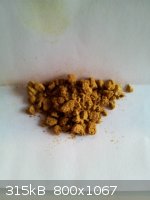 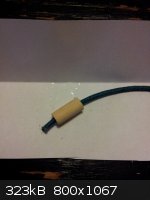 
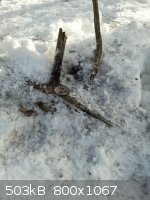 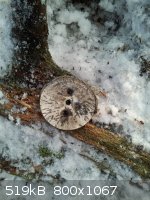 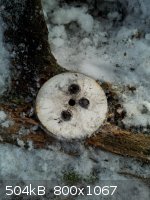
[Edited on 24-2-2014 by Hennig Brand]
"A risk-free world is a very dull world, one from which we are apt to learn little of consequence." -Geerat Vermeij
|
|
|
Rosco Bodine
Banned
Posts: 6370
Registered: 29-9-2004
Member Is Offline
Mood: analytical
|
|
When you say 7.6mm then I am understanding that to be the column diameter for the charge itself, the inside diameter of the capsule, correct? Your
small refinements are working towards finding the optimum loading or "sweet spot" conditions for a design that fits well the components you are using.
On an industrial research and development basis you would actually see charted differences for the results of column diameter variations of 0.1 mm
increments, and variations that would attend different loading pressures or progessive incremental loading schemes, and effects related to changes of
the initiator weight probably in 10-20 mg increments. So a compound detonator is a precision device exactly in the same ways as is a cartridge of
ammunition.
Every little variable will come into play, and will be magnified for a sluggish or fickle about conditions material like DDNP. My lead azide even
colloidal lead azide performs better than what you are seeing, because colloidal lead azide is something that I have used as a control standard for
comparison with other materials. But just as results may vary across a range as reported in the literature, likewise there is a peculiar uniqueness
about the combination of materials used by a particular researcher or experimenter which can produce a range of different but still believable
results, so what you are seeing occur
can be "out of range" for what I have seen, yet still be perfectly valid for your configuration which is working at a different column diameter from
what were my tests. You are actually using what is likely a good choice for diameter which is less demanding of precision but at some expense of
economy and absolute efficiency with respect to economy as a design constraint, but the thing gained is the device will be less sensitive to tiny
changes, including degradation during storage. The minimum charge that you are likely to identify at 7.6 mm will very likely be within the range of
the theory I have about the effect of geometric scaling and the disagreement I have with the conventional wisdom of the "trusted" literature which I
have learned to trust about as far as I can throw it, so far as a precisely literal translation of the literature goes. I would concur with your
observation that the literature quotes figures that are residing in an alternate universe from what I have observed, and sometimes the generalizations
made are wrong too. I think the figures are sometimes underestimating but more often are overestimating and it would seem possible that some bias may
have been involved. If you compare the theoretical with the figures used that are published for some actual devices, you will see that the actual
manufacturer used a whole lot more as a minimum charge in the actual device, than what may be indicated was minimum found in a research setting. There
is a real difference between minimum theoretical from experiment and minimum practical for actual practice, which brings variables not counted in an
experimental setting.
A suggestion I would offer for the hardwood bushing is that when the fuse is inserted through it as shown, lard the outside of the protruding fuse
with epoxy, or superglue, or lacquer, and then withdraw it till nearly flush with the bushing to seal the fuse by what film of adhesive is dragged
back into the bushing by the procedure. When the glue has set but not yet hardened completely the fuse may be trimmed flush with a razor. An
additional refinement is to take a thread cutting die to about half to two thirds the length of the bushing and cut a thread on part of the length of
the wood bushing. During assembly the smooth portion of the bushing is inserted just so far as the beginning of the thread, and the exposed thread is
larded with adhesive retained in the thread and then the bushing and fuse may be inserted to full depth. The adhesive when hardened in the thread
effectively locks the bushing and makes a permanent assembly, while the wood bushing itself should function as a pretty effective reenforcing cap. It
is possible but unlikely that any adhesive will migrate and contact the energetic materials, but a precautionary test is a good idea to see if there
are any ignition hazards where an adhesive that would be used reacts with the energetic material, just to be sure there is no issue in the event that
unintended contact with an adhesive occurred. It may be found that some stock standard part stepped diameter shoulder bushings are sold as circuit
board standoffs, and may serve the same purpose. I am certain I have seen such electronic parts as might be directly adaptable for such use, made
from various plastic, ceramic, and metal materials. It would not be difficult to make a forming die for casting or injection forming from some plastic
material such bushings if there was a need for making several, to save the trouble of turning them individually on a lathe.
In the alternative a stepped diameter bushing could be rolled from that kraft paper gummed packaging tape which must be moistened by a wet sponge to
activate the adhesive, like is used to roll tubes for pyrotechnics. If the tube was rolled on a spindle full length with a few turns to form a tube
less than the finished diameter, then a few more turns of a less wide strip could be added to build the diameter to what is a sliding fit for the
finished part after it has dried and cured. This would provide a shouldered bushing made of paper which is actually quite strong. Alternately one
continuous strip of the tape could be used having a full width portion which is wound first and steps down in width to more narrow strip wound to
complete the stepped diameter tube. A few prototype strips of slightly different length could be wound to determine the dried dimensions of the
parts and then the exact lengths required for each width section of the tape would be known, so that the part could be reproduced easily. Instead of
an abruptly stepped diameter transition, the full width smaller finished diameter section could be wound first a few turns and then a tapered winding
done simply by using a length of tape which is fixed width just long enough to make the starting turns and then tapers in width to a fixed more narrow
width desired for the transition diameter of the larger diameter end.
The end result would be a cylinder having a fixed diameter bushing effect at one end for a certain length, which would taper to a smaller diameter
along the further length. Adhesive could be applied to the tapered portion exposed after the cylindrical portion of the bushing is inserted. For a
very viscous adhesive such a tapered bushing arrangement would work better.
[Edited on 23-2-2014 by Rosco Bodine]
|
|
|
roXefeller
Hazard to Others
  
Posts: 463
Registered: 9-9-2013
Location: 13 Colonies
Member Is Offline
Mood: 220 221 whatever it takes
|
|
So why do you think that the hole in the witness plate didn't quite come through clean? Did you use hot melt again to attach the two? You had
mentioned lacquer before, yes?
|
|
|
Hennig Brand
International Hazard
    
Posts: 1284
Registered: 7-6-2009
Member Is Offline
Mood: No Mood
|
|
Just added the word diameter to the above title, it was an oversight leaving it out. No, I used lacquer this time to water proof the cap end, not hot
melt glue. The picric acid was initiated, but may not have been overdriven as much as when more DDNP was used. Quite a few interesting ideas Rosco.
The picture of the bushing is a bit misleading. The bushing was pressed into place and then the fuse inserted before sealing the cap end with a glob
of hot melt glue. The hole drilled in the bushing did match the fuse diameter almost perfectly however.
Yeah, practically a rather large excess of primary is always used I guess. I read that about 0.3g of lead azide is used in military detonators to
initiate a RDX or PETN base charge (IIRC) which is a lot more than is actually needed. The inside diameter of these military caps is 1/4" IIRC. They
are thinking about reliability over the long term when they load these caps. Even if the primary becomes significantly degraded after five or more
years in storage they have added enough extra primary to ensure that the cap will still function properly.
I originally thought that using less DDNP was resulting in less output from the picric acid base charge. However, after closer examination of the
witness plate, there is practically no difference between the tests done with 0.7g DDNP and 0.5g of DDNP initiating 1.5g of picric acid. The trial
using 1g of DDNP and 2g of picric acid did produce superior results, but the extra weight of picric acid could have accounted for that. I will perform
a test using 0.5g of DDNP and 2g of picric acid which should further my understanding of what is actually happening.
It is important to note that the efficiency of DDNP benefits greatly from the extra confinement provided by the reinforcing cap, whereas with lead
azide the benefits from increased confinement are practically negligible in comparison. The following table taken from the Matyas text illustrates
this.
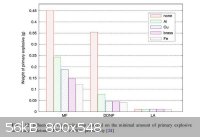
Pictures of the top and bottom of the witness plate. The hole to the right is from the last test.
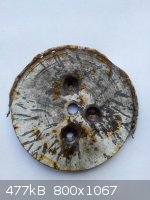 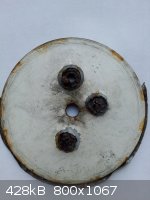
[Edited on 24-2-2014 by Hennig Brand]
"A risk-free world is a very dull world, one from which we are apt to learn little of consequence." -Geerat Vermeij
|
|
|
Ral123
National Hazard
   
Posts: 735
Registered: 31-12-2011
Member Is Offline
Mood: No Mood
|
|
I guess the DDNP is a good choice where you want to separate the primary and the base charge with a membrane or something. Then the LA won't work well
in small amounts anyway so you may use DDNP.
If you make a stability test of the DDNP, that would be great. A sample of LA was left on the sun in the summer in a black container. It didn't change
colour or behaviour after months of sitting there. Neither did a Tetryl sample. I wonder how would DDNP be.
|
|
|
Hennig Brand
International Hazard
    
Posts: 1284
Registered: 7-6-2009
Member Is Offline
Mood: No Mood
|
|
Membrane? I haven't been using any sort of membrane.
According to the literature DDNP is quite stable; however, it is sensitive to sunlight. This is not an issue for me, since it is very easy to keep it
out of the sunlight. Apparently it is mostly the surface of the DDNP particles that are altered by sunlight and this outer layer apparently protects
the inner material to a high degree. I personally just keep it out of the light. I don't think DDNP is as storage stable as lead azide, but it is
still pretty good.
[Edited on 24-2-2014 by Hennig Brand]
"A risk-free world is a very dull world, one from which we are apt to learn little of consequence." -Geerat Vermeij
|
|
|
Hennig Brand
International Hazard
    
Posts: 1284
Registered: 7-6-2009
Member Is Offline
Mood: No Mood
|
|
2g of Picric Acid Initiated in 7.6mm id Al Tubing by 0.50g of Hand Pressed DDNP Using Steel Reinforcing Cap
Because a lot of my posts are becoming very repetitive, I will simply state that this cap was loaded exactly like the last one, except that instead of
1.5g of picric acid 2g was used. The test was a success and from examining the witness plate there is very little difference between the earlier test
using 1g of DDNP to initiate 2g of picric acid and this test using 0.50g of DDNP to initiate 2g of picric acid. Once DDNP reaches high velocity
detonation it is a very effective primary. I would imagine that I could even go less than 0.50g of DDNP with the cap configuration and purity of DDNP
I am using now. It probably wouldn't take that much more DDNP to initiate TNT, except for the fact that the base charge diameter would need to be
larger. Probably could still keep the reinforcing cap id at 1/4" though.
I think the purity of my crude DDNP was a big performance issue. I also think that using the locking, tight, friction fitted bushing in behind the
reinforcing cap is really improving confinement. DDNP can also easily be over pressed. Lately I have just been pressing it by hand with good results.
Unlike LA, DDNP requires very strong confinement to be efficient, but if those needs are met it is in fact a very good primary.
DDNP is a demanding material and a lot more understanding is required to use it effectively and efficiently as compared to the other common primaries.
The hole on the right, in both witness plate shots, is from this test. The witness plate is the same beat up 3mm thick steel hole saw disc from the
earlier tests.
I would like to thank Rosco for helping me analyse these tests so far. He saw things that I initially didn't, which comes with experience I guess.
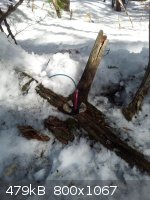  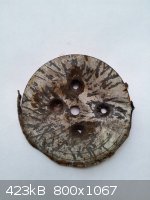 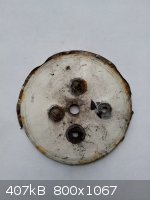
[Edited on 24-2-2014 by Hennig Brand]
"A risk-free world is a very dull world, one from which we are apt to learn little of consequence." -Geerat Vermeij
|
|
|
Rosco Bodine
Banned
Posts: 6370
Registered: 29-9-2004
Member Is Offline
Mood: analytical
|
|
You are welcome for whatever helpful information I have provided. It is really a good photo documentary and discussion that is bearing out the truth
of some things I have stated from the time of the early discussions about how picric acid is really the one energetic material you want to know well,
and have available if you had a choice to pick one of the many energetic materials as most useful. It is the derivatives like DDNP and related
derivatives, and the 3 flash igniters that are derivatives also which makes picric acid special. Picric acid is unique in the position it occupies as
an easily made energetic material having derivatives that are also useful for making a firing train, and the resulting system will be reasonably safe,
and storage stable, and will be a system having significant output. There is a lot of interest in "green" technology "lead free" energetic materials
also, and DDNP actually does already fit that description of being "green technology" for applications where a lead free requirement is imposed. It
is likely possible to use DDNP in a synergistic mixture with a quicker unequivocal primary like silver azide or some of the green friendly tetrazole
primaries, to reduce the loading requirement related to the minimum charge as would result from accellerating the DDNP with a quicker primary in a
composite. The economics of such a composite would likely be commercially viable for manufacture particularly of inexpensive fuse caps. Arts and
practices for expedient blasting is something that has been around for over a hundred years, but I'm not sure we should be talking about this
sensitive information on the internet, since the Chinese might learn of this and become involved in manufacturing fireworks 
An idea that could be worth trying regarding the recrystallization scheme and strategy of dissolving the DDNP in acetone and then adding water to the
acetone dropwise.
It may be helpful to use instead of straight water a 10% to 30% water in acetone mixture that is injected through a capillary bore tubing like from a
syringe pump if you have one, with the discharge tip of the capillary in the vortex current of a stirrer where the slowly discharging moist acetone is
being sheared and well mixed by the current flowing past the discharge of the capillary near the stirrer bar or blade, to enable a very smooth
gradient mixing to occur which should favor good crystal development in a very smooth and very gradually modified solubility system. As the
solubility is being ever so slowly reduced by such technique, the crystals having time to grow should develop more fully than when a crash
precipitation occurs on a huge amount of local nucleation as occurs when straight water is being dripped into the acetone. Crash precipitations favor
a colloidal microcrystalline precipitate having lower density and smaller crystals. There will be found an optimum injection rate for the moist
acetone. In the alternative a cosolvent non aqueous precipitation solvent could be used, like modifying the acetone solution of DDNP solubility
downward by gradual addition of methanol or toluene or some other non aqueous solvent, and this could lead to even larger crystals or a different
shape crystal. It is also possible to dissolve a percentage of something like a nitrated polyol like PETN in the acetone along with the DDNP and
coprecipiate the composite mixture which may have improved properties.
[Edited on 25-2-2014 by Rosco Bodine]
|
|
|
Ral123
National Hazard
   
Posts: 735
Registered: 31-12-2011
Member Is Offline
Mood: No Mood
|
|
You suggest lead picrate may be able to set off TNP? I suppose that would take quite heavy steel piping.
Hennig, in case light gets to DDNP, the outer layer will give NOx decomposition products(IMO) witch may start autocatalitic reaction in the rest of
the material and reduce the potency after storage a lot. The pure N2 from lead azide can't do that.
|
|
|
Hennig Brand
International Hazard
    
Posts: 1284
Registered: 7-6-2009
Member Is Offline
Mood: No Mood
|
|
Possible ways of using an unequivocal primary to get DDNP up to high velocity more quickly has been in the back of my mind lately. I am sure it can be
done and in probably more than one way. The solvent evaporation method can make very nice free flowing material, but except for the improvements with
regards to handling I don't think the benefits warrant the extra labour/time/expense. Rosco, your proposed method would probably make nice free
flowing material also.
DDNP is certainly a lot greener than most primaries for sure. However, apparently on the large scale the waste streams from DDNP production are quite
large and are none too good for aquatic life and terrestrial wildlife, etc.
Lead azide is certainly easier to use, but the fact that DDNP can be made from picric acid and works as well as it does makes me very happy.
@Ral123
If DDNP is sealed in an aluminum detonator casing I don't think light is an issue. Rosco has gone over the lead picrate detonating picric acid thing
many times. It most likely can detonate picric acid, but it would take a very impractically large amount. Lead picrate is not DDNP.
[Edited on 26-2-2014 by Hennig Brand]
"A risk-free world is a very dull world, one from which we are apt to learn little of consequence." -Geerat Vermeij
|
|
|
| Pages:
1
..
4
5
6
7
8
..
33 |